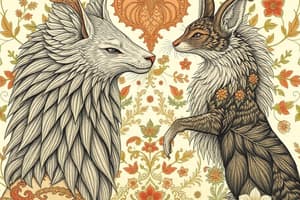Podcast
Questions and Answers
Match the following features of human language with their explanations:
Match the following features of human language with their explanations:
Use of vocal-auditory channel = Communication possible while performing other actions and over long distances Total feedback = Speakers hear their own speech and can monitor it Arbitrariness = Arbitrary relation between form and meaning Semanticity = Not available in the provided context
Match the following examples with the language features they illustrate:
Match the following examples with the language features they illustrate:
Hond (Afrikaans) means dog = Arbitrariness Bees perform a round dance when nectar is within 1m from the hive = Arbitrariness Louder barking in dogs indicates more aggression = Non-arbitrary relation between form and meaning Sign language is a means of communication = Use of non-vocal-auditory channel
Match the following advantages with the feature of human language they are associated with:
Match the following advantages with the feature of human language they are associated with:
Communication possible while performing other actions = Use of vocal-auditory channel Speakers can monitor and correct their speech = Total feedback Language can be used to communicate over long distances = Use of vocal-auditory channel Animal languages have a direct relation between form and meaning = Not a feature of human language
Match the following statements with the features of human language they describe:
Match the following statements with the features of human language they describe:
Match the following features with their descriptions:
Match the following features with their descriptions:
Match the following language features with their descriptions:
Match the following language features with their descriptions:
Match the following languages with their corresponding words for 'salt':
Match the following languages with their corresponding words for 'salt':
Match the following bird species with their language learning characteristics:
Match the following bird species with their language learning characteristics:
Match the following concepts with their definitions:
Match the following concepts with their definitions:
Match the following language features with their examples:
Match the following language features with their examples:
Match the following animal species with their unique language feature:
Match the following animal species with their unique language feature:
Match the following types of bee dances with their corresponding distances from the hive:
Match the following types of bee dances with their corresponding distances from the hive:
Match the following language features with their descriptions:
Match the following language features with their descriptions:
Match the following language characteristics with their unique aspects:
Match the following language characteristics with their unique aspects:
Match the following examples with their corresponding language features:
Match the following examples with their corresponding language features:
Match the following language units with their corresponding characteristics:
Match the following language units with their corresponding characteristics:
Match the following linguistic operations with their descriptions:
Match the following linguistic operations with their descriptions:
Match the following sentence types with their formation rules:
Match the following sentence types with their formation rules:
Match the following linguistic features with their implications:
Match the following linguistic features with their implications:
Match the following characteristics of human language with their uniqueness:
Match the following characteristics of human language with their uniqueness:
Flashcards are hidden until you start studying




